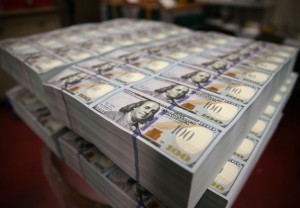 Reports are coming in from all over the world that foreign reserves are falling at lightning speed rates. The Saudis recently reported that they are expecting to lose ar the very least 120 billion Riyal (32 billion USD) from just having so many enterprises and companies abroad.
Reports are coming in from all over the world that foreign reserves are falling at lightning speed rates. The Saudis recently reported that they are expecting to lose ar the very least 120 billion Riyal (32 billion USD) from just having so many enterprises and companies abroad.
Considering that the Saudis have the United States as their closest trading partner, it’s not unreal to believe that the US is sailing in the very same boat.
Since we are already on the topic of Saudis, let’s take a look at how they are trying to combat this issue.
Foreign reserves are falling
The most immediate danger for the banks are the foreign reserves that are taking the largest hits. The Saudis decided that it would be much safer to take around $40 billion out of the central bank’s foreign reserves and transfer it into a sovereign fund. This would help ease the damage that the funds were already taking, hinting that the Saudi economy was in big danger.
Consider the fact that the Saudis have been trying to diversify their economy for more than a decade now, so all of these issues cannot be associated with oil price drops or anything similar. This is a true representation of a diversified economy suffering the perils of a global pandemic.
How is the world reacting
By removing so much from the foreign reserves, it’s very likely that the USD will appreciate relative to the Saudi Riyal, thus compelling many institutions and banks to start trading once again.
This is particularly good news for licensed American Forex brokers that would immediately start dumping their Riyal reserves and promote supplying more USD to the market.
But the issue is that the funds taken from the foreign reserve are not gone or anything, they’re just on a different account. But that doesn’t mean the prices will not react, in fact, they already have.
But the USD fell did it not?
The USD fell due to repeated action from the Federal Reserve to at least somehow combat the economic devastation that COVID-19 was causing. This paired up with controversies flaring up bout the WHO potentially underestimating the severity of the pandemic and we get a group of investors that are either panic selling or wishful buying.
No matter which of these is more dominant on the markets right now the reaction is quite clear, there is no recovery to be seen in the economy for the foreseeable future in the US. This is not because the situation is hopeless or anything, but because of the anticipation of 2020s economic growth. Now that there’s almost no way to reach the goal, investors will be more compelled to sell their assets and invest in safe havens such as gold or just cold hard cash.
Pension funds running dry
It’s no secret that every single reserve that the United States has currently is running dry. This is mostly due to income sources being extremely minuscule compared to what they were in the past. Not only have the largest companies stopped paying taxes due to paused operations, but they’re also requesting bailouts in order to survive the winter.
Although the bailouts are sometimes justified, the US also needs to think about the people who will still not have a place to work after all of this is done. This includes Americans living off-of pensions and grants as well as welfare neighborhoods.
Should these funds run completely dry, it is expected for poverty to skyrocket within a couple of weeks. People will either lose their homes completely, or homeownership will continue to concentrate very heavily with only a few individual companies or landlords.
This means much less economic diversification in poor neighborhoods and therefore an almost impossible challenge or re-vitalizing them for the future. Once every egg is in only one basket, it becomes even harder to keep them safe. The same goes for the housing market. Should only a handful of companies have ownership of a region’s housing market, it’s very unlikely for money to circulate in that community, and therefore create a deficit for the unemployed, the employed and the employers themselves.
The bottom line
The bottom line is that monetary and fiscal policies in the United States may ease the issues that are being prevalent today, but it will not remove them completely by at least Q1 of 2021. All of this is mostly based on our perception of value, and that not reaching imaginative goals is somehow a sign that things are going terribly wrong. Sure, there may be little or no growth in the US economy, but that doesn’t mean things are terrible, it is still going to be the #1 country in the list.
